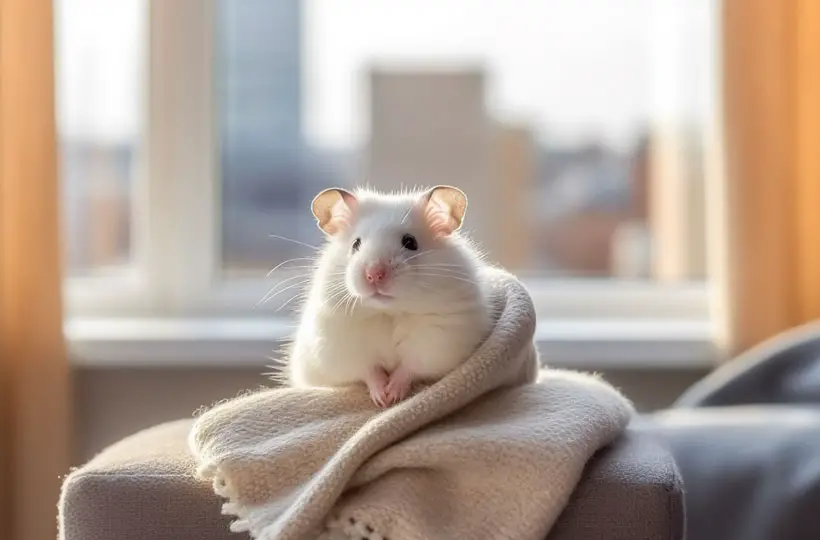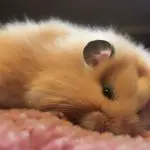Winter-White Hamster Care Guide: Food, Habitat, Health, and Facts
If you heard of Winter-White hamsters for the first time, you should know you’re not alone. These adorable little creatures are little-known but cute as hell. They’re small, fluffy, and adorable. But proper care is essential if you want one of these as your pet friend.
So, how to care for these charming furballs? Simply, you need to provide a suitable habitat, a balanced diet, and regular health check-ups.
As you can imagine, there’s a lot to learn if you want to realize these tasks. Do you want to learn about proper Winter-White hamster care? Well, You’ve come to the right place. Here, we’ll cover everything from their origins to their dietary needs and even some fun facts about these critters. So, let’s dive in!
Quirky And Must-know Facts About Winter-white Hamsters
Before delving into their care, let’s get to know some interesting facts about winter-white hamsters:

1. Size and weight: Winter-Whites are quite smaller than the typical length of all other species of hamsters. Thus, they are called “dwarfs”.
2. Color and coat types: These furry friends come in 3 main colors:
- Normal (gray-brown)
- Sapphire (blue-gray)
- Pearl (white)
According to a report by Nature Controversy, a well-reputed nonprofit and global organization, their fur changes to white during the winter, hence their name becomes (“white”)!
3. Lifespan: Winter-Whites have a small lifespan of 1.5-2.5 years.
4. Hibernation: Winter-whites are able to hibernate. In this state, they can reduce their metabolism and body temperature to conserve energy.
During hibernation, their heart rate drops to just a few beats per minute, and they can survive for several weeks without food or water.
5. Behavior: Winter-white hamsters are primarily nocturnal and are most active at night. Additionally, unlike other hamsters, they are not great climbers and prefer to stay close to the ground.
These hamsters are able to sleep with their eyes open, which allows them to be alert to any potential danger while they rest.

They make soft squeaking noises when they are content or excited. They also arch their backs when they are feeling threatened or stand on their hind legs to show aggression.
6. Scent marking: Winter-white hamsters have scent glands located on their flanks that they use to mark their territory.
They rub their scent glands on objects in their environment to leave a scent trail and mark their territory.
7. Burrowing habits: Winter-white hamsters are natural burrowers and will dig tunnels and burrows in their habitat.
8. Winter-white hamster vision: Winter-white hamsters have poor eyesight. So, they rely more on their sense of smell and hearing to navigate their environment.
Habitat and Housing
Naturally, Winter-White dwarf hamsters are natural native habitants of Siberia, Manchuria, Kazakhstan, and Mongolia. They reside in meadows, grass or crop fields, and lush forests. But they can also live in your home if you know how to set up the right habitat for them.

A. Choosing the right cage
A cage built with the wrong dimensions can be responsible for the bad health of your pet critter. So, keep a careful check on the following:
Size requirements
A cage measuring at least 24 inches (61 cm) in length, 12 inches (30cm) in width, and 12 inches (30 cm) in width is essential. Remember that, the bigger, the better!
Bar spacing and materials
Look for cages with bars spaced no more than ¼ inch (0.6 cm) apart. And avoid wire floors, which can hurt their little feet.
B. Bedding and nesting materials
Paper-based or aspen bedding is great. Avoid cedar or pine – they can cause respiratory issues (supported by a 2006 study by Laboratory Animals, a peer-reviewed journal ).
C. Cage setup
The cage must have some items to keep the hamster healthy. Such as:
- Hiding spots: Provide at least one hiding spot for your hamster to feel safe and secure.
- Exercise wheel: A solid, 6.5-inch (16.5 cm) diameter wheel will keep your hamster fit and entertained.
- Climbing structures and toys: Add tunnels, bridges, and chew toys to enrich your hamster’s environment.
D. Environmental factors
The environment must perfectly mimic the natural habitat of these critters, so they can stay healthy.
- Temperature and humidity: Maintain a temperature of 65°-75°F (18°-24°C) and humidity between 40%-60%.
- Lighting: Provide a day-night cycle with 12-14 hours of daylight.
E. Cleaning and maintenance
Clean your hamster’s cage at least once a week to keep it fresh and odor-free.
Nutrition and Feeding

You’ve gotta be careful of what you feed to your pet hamster. So, pay attention to this section.
A. Essential nutrients
Winter-White dwarf hamsters are omnivores, which means they eat seeds, plants, and meat (insects). They need a balanced and varied diet containing all the essential nutrients and minerals they need.
A balanced diet for a dwarf hamster consists of 16%-24% of protein, 60%-65% of carbohydrates, and 5%–7% of fat. They also need a constant supply of fresh drinking water, preferably from a bottle with a valveless sipper tube.
B. Recommended diet

Here’re some healthy food recommendations that you can try.
Commercial hamster food
You can feed your hamster a wide variety of fruit, vegetables, seeds, and a limited amount of pellets and insects.
You can buy a food mix or make your own. But make sure it does not have artificial colorings or preservatives.
Some examples of commercial hamster food that we endorse are Vitakraft Vita Prima Formula and Kaytee Forti Diet Pro Health Hamster Food.
Fresh fruits and vegetables
You can enhance your hamster’s food list with a tiny dosage of vitamin-packed fruits and vegetables. Cucumber slices and fresh strawberries are good options.
Other examples of fresh food are asparagus and broccoli as vegetables and bananas and berries as fruits.
Start by feeding your hamster one small piece of produce a week, then slowly move up to feeding them a small piece once a day.

Treats and supplements
You should offer your hamster treats packed with nutrients and vitamins, such as cottage cheese, boiled eggs, mealworms, or sunflower seeds.
You can also give your hamster supplements such as mineral blocks or salt licks to provide them with extra minerals.
C. Feeding schedule and portion control
You should feed your hamster about 1 tbsp (15 grams) of nutritionally balanced food each day. You can put their food in flat dishes or directly on the cage floor, but expect them to turn it over to transfer the contents to their larder.
You should also check their food stash regularly and remove any spoiled or moldy food. Thus, avoid sudden dietary changes and stale food, as this can upset their stomach.

D. Foods to avoid
Steer clear of citrus fruits, onions, garlic, and sugary or salty snacks.
Health and Wellness
There are some common illnesses that often occur in pet hamsters. So, let’s learn about them below so you can recognize them when they appear.
A. Common health issues
The below-mentioned health complications are quite common in Winter White hamsters.
Wet tail
It is a strong type of diarrhea that calls for the immediate attention of an animal husbandry doctor.
Dental problems
Overgrown teeth can cause pain and difficulty eating.
Respiratory infections
Watch for traits such as sneezing and discharge from the eyes or nose.
B. Preventative care
“Staying away before it occurs” is the best strategy to prevent pet diseases. So, keep in mind the following stuff:

Regular check-ups:
A visit to the veterinary physician every 6-12 months can help catch issues early.
Monitoring weight and behavior
Keep an eye on your hamster’s weight and watch for changes in their habits.
C. Signs of illness and when to consult a veterinarian
Lethargy, weight loss, or changes in appetite always warrant a trip to the vet.
If you’re interested in Winter White hamster care, you might also find our articles on Teddy Bear hamster care and Winter White dwarf hamster lifespan helpful. Our article on Teddy Bear hamster care offers insights into their specific care needs, including diet, habitat, and handling tips. Additionally, if you’re curious about the lifespan of Winter White dwarf hamsters, our article on Winter White dwarf hamster lifespan provides information on their average lifespan and factors that can influence it. By exploring these articles, you’ll gain a better understanding of the care practices for Teddy Bear hamsters and the lifespan of Winter White dwarf hamsters.Frequently Asked Questions
Here are the common questions that you might have in mind.
Q: Can Winter-White Dwarf hamsters live alone in human homes?
Yes, Winter-White hamsters can live alone in human homes as long as they are well cared for and interacted with regularly.
Q: Do Winter-White hamsters like hot or cold?
Winter-White hamsters are native to regions with cold and snowy winters. However, this definitely doesn’t mean that they like extremely cold temperatures.
In fact, Winter-White hamsters need a warm and cozy burrow to survive the winter. Therefore, Winter-White hamsters do not like hot or cold but prefer a moderate and stable temperature range.
Q: How do I keep my Winter-White Dwarf hamster warm at night?
You can use a small blanket to cover the cage, but make sure it does not restrict airflow or ventilation. Also, place a heating mat or pad under the cage, but not too close to the hamster or its bedding.
Or, create a small nest for your hamster using bedding materials such as wood shavings, paper towels, or hay.
Final Words
So there you have it, a comprehensive guide to Winter-White hamster care.
To wrap it all up, remember to provide a suitable habitat, a balanced diet, and regular health check-ups. Especially remember to give each hamster separate living spaces as they are territorial in nature. So, as long as they’re left alone in their own spaces, they’ll be happy.
Your Winter-White hamster relies on you for a happy and healthy life, so always be attentive and caring.
Happy hamster parenting!!!




